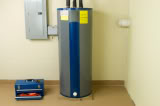How to Get the Most Out of Your Water Heater
How to Get the Most Out of Your Water Heater

Saving energy and saving money is a clear win-win situation. So jump into the world of green plumbing and energy conservation by applying some of the tips mentioned below. The ideal for energy efficient water heating is to install a tankless water heater or a solar water heating system. But this is not always economically or financially ideal for many homeowners. Those living in colder cities, such as Milwaukee, Wisconsin don't benefit from these alternative energy systems as those in warmer cities such as Scottsdale, Arizona. While backup water heating systems are used to compensate for this, it still may be a better choice for some homeowners to continue using conventional hot water tanks to heat their water. Using a conventional hot water tank to heat your water along with some energy conscious habits can help to save you money each month. But make sure you remember to conserve water too as this will surely help cut down on your water bills.
There are several ways to lower your water heating costs:
1. Conserve Hot Water: Simply use less of it! Wash clothes in cold water as much as possible.
2. Turn the Water Heater thermostat down: Often the temperature is set higher than needed. Many hot water heaters are set to 150 degrees Fahrenheit which is much hotter than necessary. Turning yours down to between 115-120 degrees Fahrenheit is sufficient enough.
3. Insulate the water heater tank: This can help a lot at preventing energy loss but you need to be extremely careful not to cover up the gas heating elements and to follow all the manufacturers recommendations. It's best to hire a plumber to do this for you.
4. Purchase a new, energy efficient hot water heater: Most heaters need to be replaced after 15 years. Make sure to check the AFUE and BTU levels and that the heater is an Energy Star certified product which means that it is a good quality, energy efficient tank.
5. Insulate the water heater pipes: Insulate the first 6 feet of the hot and cold water pipes connected to the water heater.
6. Remove sediment from the tank: About every three months it's necessary to remove sediment which can obstruct the heat transfer and lower the efficiency of your heater.
7. Heat Traps: Install heat traps on the hot and cold pipes at the water heater to prevent heat loss. Heat traps are devices installed on the incoming, and sometimes outgoing, water lines to prevent heat from escaping from the stored hot water. Some new water heaters have built-in heat traps, so check your heater to see if it has one or not.
8. Drain Water Waster Heat Recovery System: Installing a drain water waste heat recovery system could help save energy. A recent U.S. Department of Energy study showed energy savings of 25% to about 30% for water heating using such a system.
Looking for a Pro? Call us (866) 441-6648

Plumbing Average Costs
Plumbers Experiences

Cast Iron Bathtub Replacement Was Definitely Not A DIY Project

Emergency Plumbing Repair Of Collapsed Sewer Pipe



